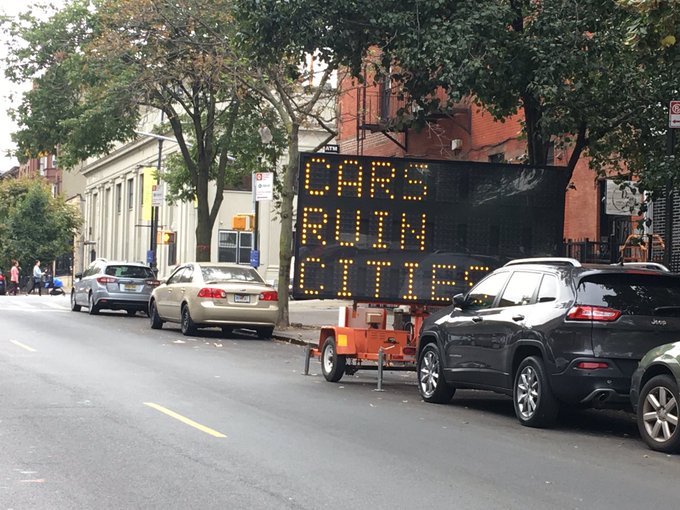What City Observatory did this week
1. We debunk the Wall Street Journal’s claim of an exodus of young adults from cities. Last week, the Wall Street Journal trumpeted an “exodus” of 25 to 39 year old adults from cities. Upon closer inspection, the data cited by the Journal simply don’t support this conclusion. When your survey-based estimates don’t reach a threshold level of statistical significance, when they’re contradicted by other, more straightforward ways of making a similar calculation (ones with a lower margin of error), when even by your own calculations at least eight major cities are recording increases in the young adult population, and when the trend you claim to have spotted has declined by 50 percent in the past year, it’s probably not valid evidence for claiming that there’s an exodus of young adults from the nation’s cities. We understand the journalistic temptation to want to be the first (or among the first) to make a provocative contrarian call about some well-known trend, but in this case the evidence is just too thin to be believable.

2. A modest proposal: EIS for DMV. Many states have environmental impact review requirements which apply to government regulatory decisions. In California and Washington State, anti-housing activists have used these state EIS-requirements to delay or block apartment development, ostensibly because of the negative environmental consequences associated with new buildings. That gave us a thought: if we’re worried about the negative environmental effect of government granting permission for something, why shouldn’t we be applying this standard to the biggest single source of greenhouse gas emissions: cars. Suppose that in order to get a new car registered, you had to file an environmental impact statement disclosing its effects on air pollution and traffic congestion. It’s not so far-fetched–in Japan, in order to register your car, you must show that you have a private-off-street parking spot for it. If the EIS for new housing is a good idea, we really ought to be applying it to cars as well.
Must read
1. Your definitive guide to road safety. David Levinson, aka The Transportist, is an invaluable resource for those interested in transportation policy. Levinson writes with the scholarly knowledge (and careful footnoting) of an academic, but with a clear and accessible voice. He has a new explainer on road safety that lays out in a balanced way all of the various strategies for reducing the carnage on the world’s roadways. Levinson catalogs, explains and quickly appraises 21 different strategies for reducing road crashes and associated injuries and deaths, ranging from roundabouts and road maintenance, to vehicle automation and urban density. It’s a quick tour of the horizon, but serves as a useful and balanced framing for thinking about safety. In the end. Levinson regards the continued (and growing) death toll on roads as an indication that we lack resolve, more than we lack knowledge:
Like congestion and global warming, the road death toll can be significantly reduced, but there is little evidence that the United States, in particular, is collectively interested in solving it. While there are obviously advocates, they do not have the upper hand, otherwise deaths would not be rising in recent years off its 2014 lows.
2. America’s most vegan/vegetarian cities. A growing proportion of the American population is either reducing or eliminating meat in their diets. Going vegan is easier in some cities than others. WalletHub has compiled an array of data about the presence and cost of vegan and vegetarian options to create a ranked list of cities nationally. By their reckoning–which is based on a complex weighted formula involving 17 different variables ranging from the number of farmer’s markets to the proportion of restaurants with vegan options–Portland is the most vegan friendly city in the nation. Here’s their list of the top 10:
| Rank | City | Score |
| 1 | Portland, OR | 66.55 |
| 2 | Los Angeles, CA | 62.72 |
| 3 | Orlando, FL | 59.74 |
| 4 | Seattle, WA | 57.86 |
| 5 | Austin, TX | 57.69 |
| 6 | Atlanta, GA | 57.52 |
| 7 | New York, NY | 57.3 |
| 8 | San Francisco, CA | 57.1 |
| 9 | San Diego, CA | 56.81 |
| 10 | Tampa, FL | 56.31 |
At the other end of the spectrum, among the 50 largest metro areas, Memphis, Tennessee has the lowest ranking for vegetarian options–apparently barbecue still dominates. There’s inherent subjectivity in choosing which weights to use for the ranking; if we ignore the affordability measures, for example, then San Francisco would edge out Portland as the #1 city for vegan and vegetarian living.
3. The biggest contributor to microplastic pollution of the oceans? Car tires. There’s been something of a fetish lately to ban the use of plastic straws as a way to reduce the amount of plastic that ends up in ocean ecosystems. While straws and six-pack rings make for gut-wrenching photos of affected wildlife, the more serious and insidious threat may be microplastics–tiny beads of plastic that are washed into rivers and streams and end up in the oceans–and their sensitive ecosystems. A new study reported in the Los Angeles Times indicates that the vast bulk of these microplastics come from car tires. Every mile you drive, a small portion of the tire is worn away in the form of tiny particles, which rain then washes into the streams and rivers. The particles get distributed throughout the food chain, and are ultimately ingested by humans. The study suggests that the volume of microplastics from tires is an amount 300 times greater than what comes from microfibers washing off polyester clothes, microbeads from beauty products and the many other plastics washing down our sinks and sewers.
4. Hacking electronic road signs. Just this, from @sugarpond on Twitter:
Apparently, if you don’t reset the default password, its relatively easy for anyone to reprogram the message on these electronic road signs. This particular warning deserves a broader audience.
New Knowledge
Household size is increasing for the first time more than a century and a half. One of the most persistent trends in US housing, the steady decline in average household sizes, has reversed since 2010, according to Census data compiled the the Pew Research Center. In this decade, the average size of a household has blipped upward, from 2.58 persons per home to 2.63 persons per home.
 For as long as anyone can remember, we’ve been building more housing faster than population has been increasing, and the combined effect of lower fertility, longer lifespans, and social preferences for living alone have pushed down the average number of persons living in a house or apartment. One of the ways to ameliorate the housing shortage is to fit more people into each dwelling unit. This reversal of the historic downward trend in household sizes suggest thats starting to happen.
For as long as anyone can remember, we’ve been building more housing faster than population has been increasing, and the combined effect of lower fertility, longer lifespans, and social preferences for living alone have pushed down the average number of persons living in a house or apartment. One of the ways to ameliorate the housing shortage is to fit more people into each dwelling unit. This reversal of the historic downward trend in household sizes suggest thats starting to happen.



